Vertical Farming Market Size 2025-2029
The vertical farming market size is valued to increase USD 13.72 billion, at a CAGR of 25.2% from 2024 to 2029. Need to meet rising demand for food products will drive the vertical farming market.
Major Market Trends & Insights
- APAC dominated the market and accounted for a 61% growth during the forecast period.
- By Product - Tomato segment was valued at USD 1.74 billion in 2023
- By Technique - Indoor vertical farming segment accounted for the largest market revenue share in 2023
Market Size & Forecast
- Market Opportunities: USD 364.14 million
- Market Future Opportunities: USD 13718.30 million
- CAGR from 2024 to 2029 : 25.2%
Market Summary
- In the global agricultural sector, vertical farming has emerged as a promising solution to address escalating food demand and environmental concerns. This innovative farming technique, which involves growing crops in vertically stacked layers under controlled conditions, has gained traction due to its efficiency and sustainability. Artificial intelligence and construction data analytics are also integral to optimizing vertical farming infrastructure. According to recent market intelligence, The market is projected to reach a value of USD16.5 billion by 2027, underscoring its growing significance. Vertical farming offers several advantages, including reduced water usage, minimal land requirements, and the ability to produce crops year-round. However, challenges persist, such as high initial investment costs and the need for advanced technology to maintain optimal growing conditions.
- Despite these hurdles, the market continues to evolve, with advancements in automation and energy-efficient systems driving progress. As businesses seek sustainable and efficient food production methods, the market is poised to play a pivotal role in shaping the future of agriculture.
What will be the Size of the Vertical Farming Market during the forecast period?
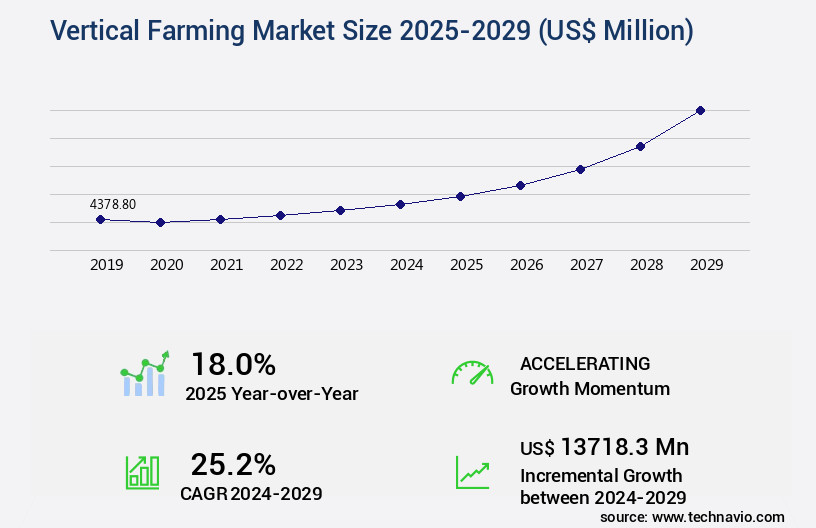
Get Key Insights on Market Forecast (PDF) Request Free Sample
How is the Vertical Farming Market Segmented ?
The vertical farming industry research report provides comprehensive data (region-wise segment analysis), with forecasts and estimates in "USD million" for the period 2025-2029, as well as historical data from 2019-2023 for the following segments.
- Product
- Tomato
- Lettuce
- Bell and chili pepper
- Strawberry
- Others
- Technique
- Indoor vertical farming
- Greenhouse vertical farming
- Hybrid systems
- Component
- Lighting systems
- Climate control systems
- Irrigation systems
- Sensors and monitoring devices
- Others
- Geography
- North America
- Europe
- APAC
- China
- India
- Japan
- South Korea
- South America
- Rest of World (ROW)
By Product Insights
The tomato segment is estimated to witness significant growth during the forecast period.
In the ever-evolving the market, the tomato segment currently dominates with a significant market share, reaching approximately 40% in 2024. This popularity is due to the high global demand for tomatoes compared to other crops like lettuce, cucumbers, and herbs. Vertical farming's economic viability is proven through the cultivation of high-demand crops like tomatoes, ensuring substantial returns for companies. Notable players, such as AeroFarms and Plenty Unlimited Inc., are actively investing in vertical farming and tomato production. Strategies like research and development are key to expanding market presence. Integral to vertical farming are advanced technologies like data analytics platforms, vertical farm infrastructure, plant health monitoring, precision fertigation, and disease detection systems.
Indoor farming techniques, integrated pest management, stacking cultivation methods, and plant spacing optimization are essential for maximizing yields. Environmental control, climate control systems, growth chamber design, substrate selection processes, yield prediction models, and crop rotation strategies are also crucial. Air circulation management, vertical farm automation, pest control strategies, harvest automation methods, vertical farming sensors, hydroponic systems, nutrient film technique, water usage efficiency, plant tissue culture, aeroponic cultivation, crop yield optimization, vertical farm design, LED grow lights, soilless growing media, energy consumption metrics, nutrient solution management, plant growth monitoring, remote sensing technology, and smart irrigation systems are all integral components of this innovative farming approach.
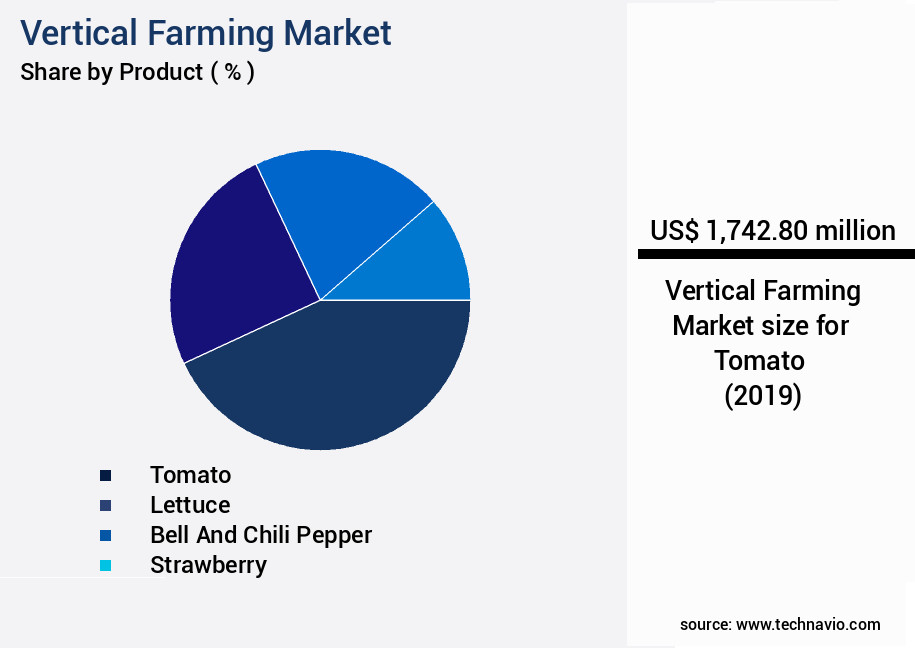
Request Free Sample
The Tomato segment was valued at USD 1.74 billion in 2019 and showed a gradual increase during the forecast period.
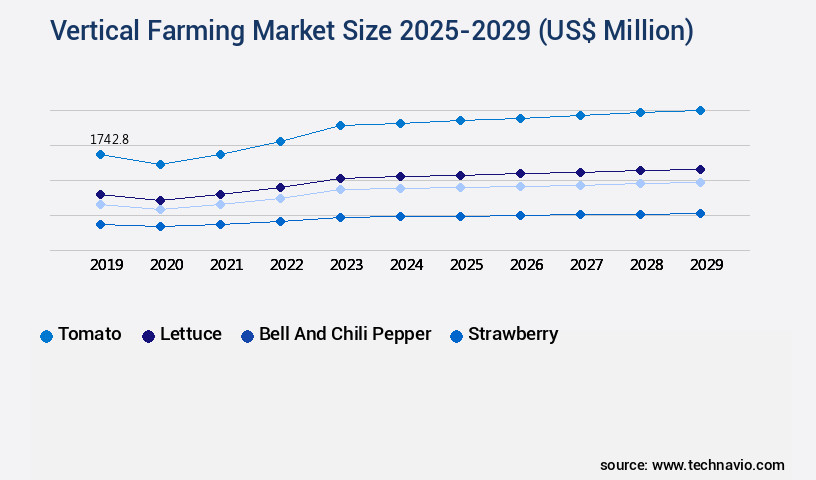
Request Free Sample
Regional Analysis
APAC is estimated to contribute 61% to the growth of the global market during the forecast period.Technavio’s analysts have elaborately explained the regional trends and drivers that shape the market during the forecast period.
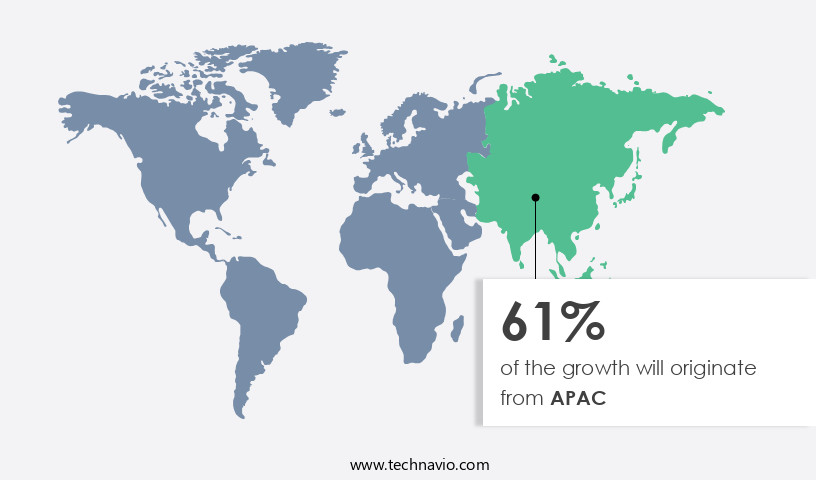
See How Vertical Farming Market Demand is Rising in APAC Request Free Sample
The market in Asia Pacific (APAC) is experiencing significant growth, fueled by the establishment of numerous vertical farms in partnership with manufacturing entities. Population expansion and the scarcity of arable land are primary factors driving the market's robust development. Japan leads the regional vertical farming sector, while Singapore gains prominence due to its land scarcity and high agricultural import reliance. Countries like China, India, Taiwan, and South Korea exhibit substantial demand for vertical farming solutions.
This trend underscores the market's potential to address food security challenges and contribute to sustainable agriculture in APAC.
Market Dynamics
Our researchers analyzed the data with 2024 as the base year, along with the key drivers, trends, and challenges. A holistic analysis of drivers will help companies refine their marketing strategies to gain a competitive advantage.
The market is experiencing significant growth as this innovative farming technique gains popularity for its ability to optimize nutrient delivery in soilless environments using hydroponics and aeroponic systems. Integrated pest management is a crucial aspect of vertical farms, ensuring the controlled indoor conditions maintain ideal environmental parameters for plant growth. Water recycling efficiency is a key advantage of vertical farming systems, as they minimize water usage through closed-loop systems. Automated harvesting techniques and energy-efficient LED lighting further enhance the productivity and sustainability of these operations. Plant disease detection using image analysis and real-time growth monitoring are essential components of vertical farming, allowing for data-driven decision making and predictive modeling of crop yields. Soilless substrate selection criteria, such as water retention capacity and nutrient availability, play a significant role in maximizing yield and efficient resource utilization. Sustainable water management techniques, including rainwater harvesting and greywater recycling, are essential for climate control strategies in indoor plant cultivation. Optimizing plant spacing in vertical farm design is crucial for efficient resource utilization and minimizing the impact of crop rotation on yields. Remote sensing technology for plant health monitoring and predictive modeling of crop yields are essential tools for vertical farm infrastructure cost analysis and ensuring the effects of plant growth regulators on productivity are optimized. In summary, the market offers numerous advantages, including optimized nutrient delivery, water recycling, energy efficiency, and sustainable resource management, making it an attractive option for businesses seeking to minimize environmental impact while maximizing yields.
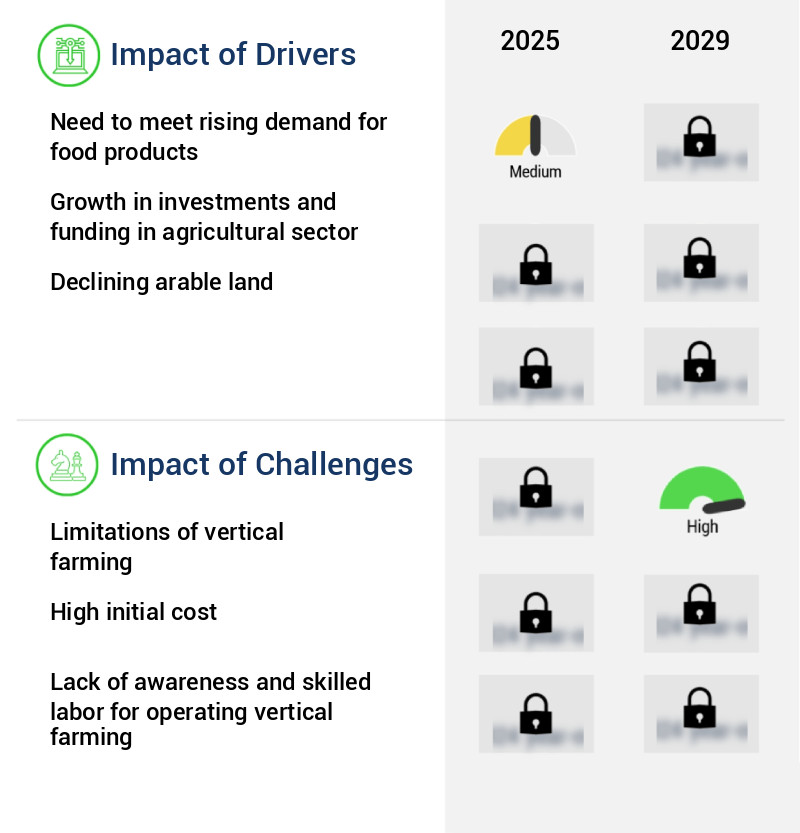
What are the key market drivers leading to the rise in the adoption of Vertical Farming Industry?
- The primary factor fueling market growth is the increasing requirement for food products.
- Vertical farming presents a groundbreaking solution to traditional agriculture, offering substantial yield advantages. This innovative approach produces 240 times more agricultural output with 99% less land usage, 95% water savings, and zero chemical application. Although vertical farming entails higher operational costs, the increased harvests translate to greater profits. Implementing light-emitting diode (LED) lighting and climate control systems in vertical farming enables constant temperature and humidity adjustments. This results in a year-round source of fresh, locally grown, pesticide-free produce. Vertical farming's flexibility allows for crops to be replanted without adhering to agricultural rotations. Furthermore, it serves as an ideal substitute for conventional farming when land availability is limited.
- Vertical farming's benefits extend beyond land and water conservation. Its controlled environment allows for precise crop management, ensuring optimal growing conditions. This farming method is particularly valuable in urban areas, where access to fresh produce can be limited. By producing locally, vertical farming reduces transportation costs and carbon emissions, contributing to a more sustainable food system. In conclusion, vertical farming represents a dynamic and evolving market, offering significant benefits to agriculture and food production. Its continuous growth and adoption across various sectors underscore its potential to revolutionize the way we grow food.
What are the market trends shaping the Vertical Farming Industry?
- Concerns over environmental impact are increasingly shaping market trends. A growing awareness of the need to reduce environmental footprints is influencing consumer preferences and business strategies.
- Vertical farming, a modern agricultural innovation, significantly contributes to environmental sustainability by minimizing water consumption and eliminating the need for transportation and chemicals in food production. This method of farming, which involves growing crops in vertically stacked layers, utilizes aquaponics as a growth mechanism. Aquaponics reduces chemical usage by employing fish to produce nutrient-rich waste for plants, offering a natural alternative. Moreover, vertical farming's controlled environment shields crops from pests, obviating the requirement for pesticides.
- By reducing water consumption and eliminating the need for herbicides, pesticides, and long-distance transportation, vertical farming offers a more eco-friendly solution for agricultural production. The shift towards this innovative farming method underscores the industry's commitment to sustainable practices and continuous evolution.
What challenges does the Vertical Farming Industry face during its growth?
- The growth of the vertical farming industry is constrained by several limitations, making it a significant challenge for this sector.
- Vertical farming, while offering controlled growing conditions for certain produce, is not a one-size-fits-all solution. The market scope for this innovative farming method is diverse, yet limited to specific fruits and vegetables. Popular choices include lettuces, kales, chard, collard greens, chives, tomatoes, lemon, and cinnamon. The reasons for their selection lie in their adaptability to vertical farming conditions. However, calorie-rich foods, which necessitate higher food security, are generally not viable options in this farming method.
- As a result, farmers may continue to practice traditional farming techniques to cater to the demand for a broader range of produce, thereby ensuring a balanced agricultural landscape.
Exclusive Technavio Analysis on Customer Landscape
The vertical farming market forecasting report includes the adoption lifecycle of the market, covering from the innovator’s stage to the laggard’s stage. It focuses on adoption rates in different regions based on penetration. Furthermore, the vertical farming market report also includes key purchase criteria and drivers of price sensitivity to help companies evaluate and develop their market growth analysis strategies.
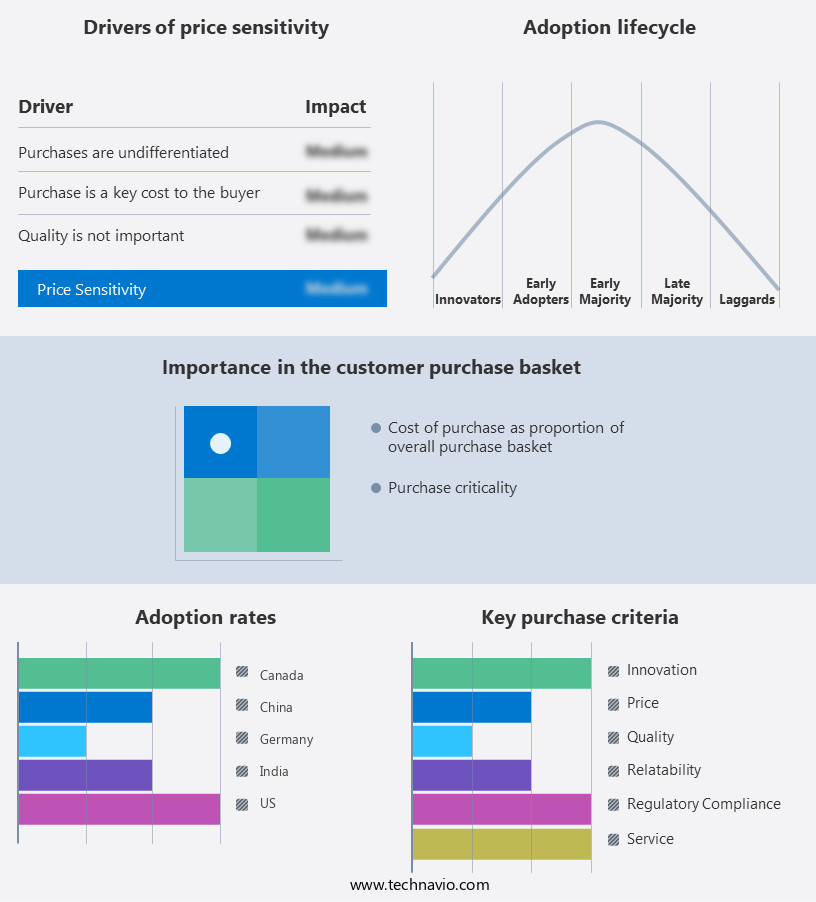
Customer Landscape of Vertical Farming Industry
Competitive Landscape
Companies are implementing various strategies, such as strategic alliances, vertical farming market forecast, partnerships, mergers and acquisitions, geographical expansion, and product/service launches, to enhance their presence in the industry.
AS GIRI AND AQUA LLP - This company specializes in vertical farming systems, utilizing soil-based polyhouse structures for year-round cultivation of crops such as turmeric, tomatoes, and ginger. These innovative systems significantly reduce water and land consumption compared to traditional farming methods.
The industry research and growth report includes detailed analyses of the competitive landscape of the market and information about key companies, including:
- AS GIRI AND AQUA LLP
- Bowery Farming Inc.
- Dream Harvest Farming Company LLC
- Eataly Net USA LLC
- Elevate Farms
- Hortifrut SA
- Kalera Inc
- Nordic Harvest AS
- Plenty Unlimited Inc.
- SPREAD Co. Ltd.
- Triton Foodworks
- Upward Enterprises Inc.
- URBAN GREEN FATE FARMS
- UrbanKisaan
- Vertical Harvest
- Vertical Roots
- Village Farms International Inc.
Qualitative and quantitative analysis of companies has been conducted to help clients understand the wider business environment as well as the strengths and weaknesses of key industry players. Data is qualitatively analyzed to categorize companies as pure play, category-focused, industry-focused, and diversified; it is quantitatively analyzed to categorize companies as dominant, leading, strong, tentative, and weak.
Recent Development and News in Vertical Farming Market
- In January 2024, BrightFarms, a leading vertical farming company, announced the launch of its newest hydroponic farm in California, increasing its total farm footprint by 30 acres (BrightFarms Press Release). This expansion marked a significant geographic entry for the company into the Western US market.
- In March 2024, Plenty, a vertical farming technology company, secured a strategic partnership with Walmart, the world's largest retailer, to supply fresh produce to over 1,500 Walmart stores across the US (Plenty Press Release). This collaboration represented a major milestone for Plenty, as it significantly expanded its customer base and strengthened its market position.
- In May 2024, Infarm, a German vertical farming startup, raised a USD200 million Series D funding round, bringing its total funding to over USD370 million (Infarm Press Release). The investment was led by Atlas Venture and Baillie Gifford, and it would be used to accelerate Infarm's global expansion and product development efforts.
- In February 2025, the Dutch government announced a €100 million (USD113 million) investment in vertical farming initiatives, including the construction of a large-scale vertical farm in the Hague (Netherlands Enterprise Agency Press Release). This initiative aimed to reduce the country's reliance on imported produce and promote sustainable agriculture.
Dive into Technavio’s robust research methodology, blending expert interviews, extensive data synthesis, and validated models for unparalleled Vertical Farming Market insights. See full methodology.
|
Market Scope
|
|
Report Coverage
|
Details
|
|
Page number
|
218
|
|
Base year
|
2024
|
|
Historic period
|
2019-2023 |
|
Forecast period
|
2025-2029
|
|
Growth momentum & CAGR
|
Accelerate at a CAGR of 25.2%
|
|
Market growth 2025-2029
|
USD 13718.3 million
|
|
Market structure
|
Fragmented
|
|
YoY growth 2024-2025(%)
|
18.0
|
|
Key countries
|
US, Canada, India, China, Japan, Brazil, Germany, UK, South Korea, and France
|
|
Competitive landscape
|
Leading Companies, Market Positioning of Companies, Competitive Strategies, and Industry Risks
|
Request Free Sample
Research Analyst Overview
- The market continues to evolve, driven by advancements in technology and the growing demand for sustainable agricultural solutions. This dynamic sector encompasses various applications, from data analytics platforms and vertical farm infrastructure to plant health monitoring and precision fertigation. One notable example of market progression is the implementation of disease detection systems and integrated pest management strategies. Indoor farming techniques, such as stacking cultivation methods and plant spacing optimization, are increasingly popular. Environmental and climate control systems, including growth chamber design and substrate selection processes, are essential components of successful vertical farming operations. Yield prediction models, crop rotation strategies, and air circulation management are also crucial elements in optimizing vertical farm design.
- Vertical farm automation, pest control strategies, and harvest automation methods further enhance efficiency and productivity. Sensors, hydroponic systems, and nutrient film techniques contribute to water usage efficiency and crop yield optimization. The vertical farming industry is projected to grow at a robust rate, with experts estimating a 20% annual expansion in the coming years. This growth is fueled by the increasing adoption of LED grow lights, soilless growing media, and energy consumption metrics, among other innovations. The integration of remote sensing technology and smart irrigation systems is also transforming the sector, offering new opportunities for efficiency and profitability.
What are the Key Data Covered in this Vertical Farming Market Research and Growth Report?
-
What is the expected growth of the Vertical Farming Market between 2025 and 2029?
-
What segmentation does the market report cover?
-
The report is segmented by Product (Tomato, Lettuce, Bell and chili pepper, Strawberry, and Others), Technique (Indoor vertical farming, Greenhouse vertical farming, and Hybrid systems), Component (Lighting systems, Climate control systems, Irrigation systems, Sensors and monitoring devices, and Others), and Geography (APAC, North America, Europe, South America, and Middle East and Africa)
-
Which regions are analyzed in the report?
-
APAC, North America, Europe, South America, and Middle East and Africa
-
What are the key growth drivers and market challenges?
-
Who are the major players in the Vertical Farming Market?
-
AS GIRI AND AQUA LLP, Bowery Farming Inc., Dream Harvest Farming Company LLC, Eataly Net USA LLC, Elevate Farms, Hortifrut SA, Kalera Inc, Nordic Harvest AS, Plenty Unlimited Inc., SPREAD Co. Ltd., Triton Foodworks, Upward Enterprises Inc., URBAN GREEN FATE FARMS, UrbanKisaan, Vertical Harvest, Vertical Roots, and Village Farms International Inc.
Market Research Insights
- The market for vertical farming is a continually advancing industry, focused on producing crops in controlled environments using innovative techniques such as plant growth regulators and stress indicators. This approach to sustainable agriculture offers solutions for resource optimization, water recycling methods, and nutrient deficiencies, among other challenges. One example of market dynamics at play is a leading vertical farm increasing its sales by 30% through the implementation of precision agriculture and resource management tools. Industry growth is expected to expand at a rate of 20% annually, driven by the adoption of automation in irrigation scheduling, automated harvesting, and closed-loop systems.
- These advancements contribute to energy efficiency gains, improved crop quality assessment, and crop disease resistance. Additionally, vertical farming plays a crucial role in urban food production and food security solutions, making it a vital component of the agricultural landscape.
We can help! Our analysts can customize this vertical farming market research report to meet your requirements.
Get in touch
1 Executive Summary
- 1.1 Market overview
- Executive Summary - Chart on Market Overview
- Executive Summary - Data Table on Market Overview
- Executive Summary - Chart on Global Market Characteristics
- Executive Summary - Chart on Market by Geography
- Executive Summary - Chart on Market Segmentation by Product
- Executive Summary - Chart on Market Segmentation by Technique
- Executive Summary - Chart on Market Segmentation by Component
- Executive Summary - Chart on Incremental Growth
- Executive Summary - Data Table on Incremental Growth
- Executive Summary - Chart on Company Market Positioning
2 Technavio Analysis
- 2.1 Analysis of price sensitivity, lifecycle, customer purchase basket, adoption rates, and purchase criteria
- Analysis of price sensitivity, lifecycle, customer purchase basket, adoption rates, and purchase criteria
- 2.2 Criticality of inputs and Factors of differentiation
- Overview on criticality of inputs and factors of differentiation
- 2.3 Factors of disruption
- Overview on factors of disruption
- 2.4 Impact of drivers and challenges
- Impact of drivers and challenges in 2024 and 2029
3 Market Landscape
- 3.1 Market ecosystem
- Parent Market
- Data Table on - Parent Market
- 3.2 Market characteristics
- Market characteristics analysis
4 Market Sizing
- 4.1 Market definition
- Offerings of companies included in the market definition
- 4.2 Market segment analysis
- 4.4 Market outlook: Forecast for 2024-2029
- Chart on Global - Market size and forecast 2024-2029 ($ million)
- Data Table on Global - Market size and forecast 2024-2029 ($ million)
- Chart on Global Market: Year-over-year growth 2024-2029 (%)
- Data Table on Global Market: Year-over-year growth 2024-2029 (%)
5 Historic Market Size
- 5.1 Global Vertical Farming Market 2019 - 2023
- Historic Market Size - Data Table on Global Vertical Farming Market 2019 - 2023 ($ million)
- 5.2 Product segment analysis 2019 - 2023
- Historic Market Size - Product Segment 2019 - 2023 ($ million)
- 5.3 Technique segment analysis 2019 - 2023
- Historic Market Size - Technique Segment 2019 - 2023 ($ million)
- 5.4 Component segment analysis 2019 - 2023
- Historic Market Size - Component Segment 2019 - 2023 ($ million)
- 5.5 Geography segment analysis 2019 - 2023
- Historic Market Size - Geography Segment 2019 - 2023 ($ million)
- 5.6 Country segment analysis 2019 - 2023
- Historic Market Size - Country Segment 2019 - 2023 ($ million)
6 Qualitative Analysis
- 6.1 Impact of AI on Global Vertical Farming Market
7 Five Forces Analysis
- 7.1 Five forces summary
- Five forces analysis - Comparison between 2024 and 2029
- 7.2 Bargaining power of buyers
- Bargaining power of buyers - Impact of key factors 2024 and 2029
- 7.3 Bargaining power of suppliers
- Bargaining power of suppliers - Impact of key factors in 2024 and 2029
- 7.4 Threat of new entrants
- Threat of new entrants - Impact of key factors in 2024 and 2029
- 7.5 Threat of substitutes
- Threat of substitutes - Impact of key factors in 2024 and 2029
- 7.6 Threat of rivalry
- Threat of rivalry - Impact of key factors in 2024 and 2029
- 7.7 Market condition
- Chart on Market condition - Five forces 2024 and 2029
8 Market Segmentation by Product
- 8.1 Market segments
- Chart on Product - Market share 2024-2029 (%)
- Data Table on Product - Market share 2024-2029 (%)
- 8.2 Comparison by Product
- Chart on Comparison by Product
- Data Table on Comparison by Product
- 8.3 Tomato - Market size and forecast 2024-2029
- Chart on Tomato - Market size and forecast 2024-2029 ($ million)
- Data Table on Tomato - Market size and forecast 2024-2029 ($ million)
- Chart on Tomato - Year-over-year growth 2024-2029 (%)
- Data Table on Tomato - Year-over-year growth 2024-2029 (%)
- 8.4 Lettuce - Market size and forecast 2024-2029
- Chart on Lettuce - Market size and forecast 2024-2029 ($ million)
- Data Table on Lettuce - Market size and forecast 2024-2029 ($ million)
- Chart on Lettuce - Year-over-year growth 2024-2029 (%)
- Data Table on Lettuce - Year-over-year growth 2024-2029 (%)
- 8.5 Bell and chili pepper - Market size and forecast 2024-2029
- Chart on Bell and chili pepper - Market size and forecast 2024-2029 ($ million)
- Data Table on Bell and chili pepper - Market size and forecast 2024-2029 ($ million)
- Chart on Bell and chili pepper - Year-over-year growth 2024-2029 (%)
- Data Table on Bell and chili pepper - Year-over-year growth 2024-2029 (%)
- 8.6 Strawberry - Market size and forecast 2024-2029
- Chart on Strawberry - Market size and forecast 2024-2029 ($ million)
- Data Table on Strawberry - Market size and forecast 2024-2029 ($ million)
- Chart on Strawberry - Year-over-year growth 2024-2029 (%)
- Data Table on Strawberry - Year-over-year growth 2024-2029 (%)
- 8.7 Others - Market size and forecast 2024-2029
- Chart on Others - Market size and forecast 2024-2029 ($ million)
- Data Table on Others - Market size and forecast 2024-2029 ($ million)
- Chart on Others - Year-over-year growth 2024-2029 (%)
- Data Table on Others - Year-over-year growth 2024-2029 (%)
- 8.8 Market opportunity by Product
- Market opportunity by Product ($ million)
- Data Table on Market opportunity by Product ($ million)
9 Market Segmentation by Technique
- 9.1 Market segments
- Chart on Technique - Market share 2024-2029 (%)
- Data Table on Technique - Market share 2024-2029 (%)
- 9.2 Comparison by Technique
- Chart on Comparison by Technique
- Data Table on Comparison by Technique
- 9.3 Indoor vertical farming - Market size and forecast 2024-2029
- Chart on Indoor vertical farming - Market size and forecast 2024-2029 ($ million)
- Data Table on Indoor vertical farming - Market size and forecast 2024-2029 ($ million)
- Chart on Indoor vertical farming - Year-over-year growth 2024-2029 (%)
- Data Table on Indoor vertical farming - Year-over-year growth 2024-2029 (%)
- 9.4 Greenhouse vertical farming - Market size and forecast 2024-2029
- Chart on Greenhouse vertical farming - Market size and forecast 2024-2029 ($ million)
- Data Table on Greenhouse vertical farming - Market size and forecast 2024-2029 ($ million)
- Chart on Greenhouse vertical farming - Year-over-year growth 2024-2029 (%)
- Data Table on Greenhouse vertical farming - Year-over-year growth 2024-2029 (%)
- 9.5 Hybrid systems - Market size and forecast 2024-2029
- Chart on Hybrid systems - Market size and forecast 2024-2029 ($ million)
- Data Table on Hybrid systems - Market size and forecast 2024-2029 ($ million)
- Chart on Hybrid systems - Year-over-year growth 2024-2029 (%)
- Data Table on Hybrid systems - Year-over-year growth 2024-2029 (%)
- 9.6 Market opportunity by Technique
- Market opportunity by Technique ($ million)
- Data Table on Market opportunity by Technique ($ million)
10 Market Segmentation by Component
- 10.1 Market segments
- Chart on Component - Market share 2024-2029 (%)
- Data Table on Component - Market share 2024-2029 (%)
- 10.2 Comparison by Component
- Chart on Comparison by Component
- Data Table on Comparison by Component
- 10.3 Lighting systems - Market size and forecast 2024-2029
- Chart on Lighting systems - Market size and forecast 2024-2029 ($ million)
- Data Table on Lighting systems - Market size and forecast 2024-2029 ($ million)
- Chart on Lighting systems - Year-over-year growth 2024-2029 (%)
- Data Table on Lighting systems - Year-over-year growth 2024-2029 (%)
- 10.4 Climate control systems - Market size and forecast 2024-2029
- Chart on Climate control systems - Market size and forecast 2024-2029 ($ million)
- Data Table on Climate control systems - Market size and forecast 2024-2029 ($ million)
- Chart on Climate control systems - Year-over-year growth 2024-2029 (%)
- Data Table on Climate control systems - Year-over-year growth 2024-2029 (%)
- 10.5 Irrigation systems - Market size and forecast 2024-2029
- Chart on Irrigation systems - Market size and forecast 2024-2029 ($ million)
- Data Table on Irrigation systems - Market size and forecast 2024-2029 ($ million)
- Chart on Irrigation systems - Year-over-year growth 2024-2029 (%)
- Data Table on Irrigation systems - Year-over-year growth 2024-2029 (%)
- 10.6 Sensors and monitoring devices - Market size and forecast 2024-2029
- Chart on Sensors and monitoring devices - Market size and forecast 2024-2029 ($ million)
- Data Table on Sensors and monitoring devices - Market size and forecast 2024-2029 ($ million)
- Chart on Sensors and monitoring devices - Year-over-year growth 2024-2029 (%)
- Data Table on Sensors and monitoring devices - Year-over-year growth 2024-2029 (%)
- 10.7 Others - Market size and forecast 2024-2029
- Chart on Others - Market size and forecast 2024-2029 ($ million)
- Data Table on Others - Market size and forecast 2024-2029 ($ million)
- Chart on Others - Year-over-year growth 2024-2029 (%)
- Data Table on Others - Year-over-year growth 2024-2029 (%)
- 10.8 Market opportunity by Component
- Market opportunity by Component ($ million)
- Data Table on Market opportunity by Component ($ million)
11 Customer Landscape
- 11.1 Customer landscape overview
- Analysis of price sensitivity, lifecycle, customer purchase basket, adoption rates, and purchase criteria
12 Geographic Landscape
- 12.1 Geographic segmentation
- Chart on Market share by geography 2024-2029 (%)
- Data Table on Market share by geography 2024-2029 (%)
- 12.2 Geographic comparison
- Chart on Geographic comparison
- Data Table on Geographic comparison
- 12.3 APAC - Market size and forecast 2024-2029
- Chart on APAC - Market size and forecast 2024-2029 ($ million)
- Data Table on APAC - Market size and forecast 2024-2029 ($ million)
- Chart on APAC - Year-over-year growth 2024-2029 (%)
- Data Table on APAC - Year-over-year growth 2024-2029 (%)
- 12.4 North America - Market size and forecast 2024-2029
- Chart on North America - Market size and forecast 2024-2029 ($ million)
- Data Table on North America - Market size and forecast 2024-2029 ($ million)
- Chart on North America - Year-over-year growth 2024-2029 (%)
- Data Table on North America - Year-over-year growth 2024-2029 (%)
- 12.5 Europe - Market size and forecast 2024-2029
- Chart on Europe - Market size and forecast 2024-2029 ($ million)
- Data Table on Europe - Market size and forecast 2024-2029 ($ million)
- Chart on Europe - Year-over-year growth 2024-2029 (%)
- Data Table on Europe - Year-over-year growth 2024-2029 (%)
- 12.6 South America - Market size and forecast 2024-2029
- Chart on South America - Market size and forecast 2024-2029 ($ million)
- Data Table on South America - Market size and forecast 2024-2029 ($ million)
- Chart on South America - Year-over-year growth 2024-2029 (%)
- Data Table on South America - Year-over-year growth 2024-2029 (%)
- 12.7 Middle East and Africa - Market size and forecast 2024-2029
- Chart on Middle East and Africa - Market size and forecast 2024-2029 ($ million)
- Data Table on Middle East and Africa - Market size and forecast 2024-2029 ($ million)
- Chart on Middle East and Africa - Year-over-year growth 2024-2029 (%)
- Data Table on Middle East and Africa - Year-over-year growth 2024-2029 (%)
- 12.8 US - Market size and forecast 2024-2029
- Chart on US - Market size and forecast 2024-2029 ($ million)
- Data Table on US - Market size and forecast 2024-2029 ($ million)
- Chart on US - Year-over-year growth 2024-2029 (%)
- Data Table on US - Year-over-year growth 2024-2029 (%)
- 12.9 China - Market size and forecast 2024-2029
- Chart on China - Market size and forecast 2024-2029 ($ million)
- Data Table on China - Market size and forecast 2024-2029 ($ million)
- Chart on China - Year-over-year growth 2024-2029 (%)
- Data Table on China - Year-over-year growth 2024-2029 (%)
- 12.10 India - Market size and forecast 2024-2029
- Chart on India - Market size and forecast 2024-2029 ($ million)
- Data Table on India - Market size and forecast 2024-2029 ($ million)
- Chart on India - Year-over-year growth 2024-2029 (%)
- Data Table on India - Year-over-year growth 2024-2029 (%)
- 12.11 Japan - Market size and forecast 2024-2029
- Chart on Japan - Market size and forecast 2024-2029 ($ million)
- Data Table on Japan - Market size and forecast 2024-2029 ($ million)
- Chart on Japan - Year-over-year growth 2024-2029 (%)
- Data Table on Japan - Year-over-year growth 2024-2029 (%)
- 12.12 South Korea - Market size and forecast 2024-2029
- Chart on South Korea - Market size and forecast 2024-2029 ($ million)
- Data Table on South Korea - Market size and forecast 2024-2029 ($ million)
- Chart on South Korea - Year-over-year growth 2024-2029 (%)
- Data Table on South Korea - Year-over-year growth 2024-2029 (%)
- 12.13 Canada - Market size and forecast 2024-2029
- Chart on Canada - Market size and forecast 2024-2029 ($ million)
- Data Table on Canada - Market size and forecast 2024-2029 ($ million)
- Chart on Canada - Year-over-year growth 2024-2029 (%)
- Data Table on Canada - Year-over-year growth 2024-2029 (%)
- 12.14 Germany - Market size and forecast 2024-2029
- Chart on Germany - Market size and forecast 2024-2029 ($ million)
- Data Table on Germany - Market size and forecast 2024-2029 ($ million)
- Chart on Germany - Year-over-year growth 2024-2029 (%)
- Data Table on Germany - Year-over-year growth 2024-2029 (%)
- 12.15 UK - Market size and forecast 2024-2029
- Chart on UK - Market size and forecast 2024-2029 ($ million)
- Data Table on UK - Market size and forecast 2024-2029 ($ million)
- Chart on UK - Year-over-year growth 2024-2029 (%)
- Data Table on UK - Year-over-year growth 2024-2029 (%)
- 12.16 France - Market size and forecast 2024-2029
- Chart on France - Market size and forecast 2024-2029 ($ million)
- Data Table on France - Market size and forecast 2024-2029 ($ million)
- Chart on France - Year-over-year growth 2024-2029 (%)
- Data Table on France - Year-over-year growth 2024-2029 (%)
- 12.17 Brazil - Market size and forecast 2024-2029
- Chart on Brazil - Market size and forecast 2024-2029 ($ million)
- Data Table on Brazil - Market size and forecast 2024-2029 ($ million)
- Chart on Brazil - Year-over-year growth 2024-2029 (%)
- Data Table on Brazil - Year-over-year growth 2024-2029 (%)
- 12.18 Market opportunity by geography
- Market opportunity by geography ($ million)
- Data Tables on Market opportunity by geography ($ million)
13 Drivers, Challenges, and Opportunity/Restraints
- 13.3 Impact of drivers and challenges
- Impact of drivers and challenges in 2024 and 2029
- 13.4 Market opportunities/restraints
14 Competitive Landscape
- 14.2 Competitive Landscape
- Overview on criticality of inputs and factors of differentiation
- 14.3 Landscape disruption
- Overview on factors of disruption
- 14.4 Industry risks
- Impact of key risks on business
15 Competitive Analysis
- 15.2 Company ranking index
- 15.3 Market positioning of companies
- Matrix on companies position and classification
- 15.4 AS GIRI AND AQUA LLP
- AS GIRI AND AQUA LLP - Overview
- AS GIRI AND AQUA LLP - Product / Service
- AS GIRI AND AQUA LLP - Key offerings
- SWOT
- 15.5 Bowery Farming Inc.
- Bowery Farming Inc. - Overview
- Bowery Farming Inc. - Product / Service
- Bowery Farming Inc. - Key offerings
- SWOT
- 15.6 Dream Harvest Farming Company LLC
- Dream Harvest Farming Company LLC - Overview
- Dream Harvest Farming Company LLC - Product / Service
- Dream Harvest Farming Company LLC - Key offerings
- SWOT
- 15.7 Eataly Net USA LLC
- Eataly Net USA LLC - Overview
- Eataly Net USA LLC - Product / Service
- Eataly Net USA LLC - Key offerings
- SWOT
- 15.8 Elevate Farms
- Elevate Farms - Overview
- Elevate Farms - Product / Service
- Elevate Farms - Key offerings
- SWOT
- 15.9 Hortifrut SA
- Hortifrut SA - Overview
- Hortifrut SA - Business segments
- Hortifrut SA - Key offerings
- Hortifrut SA - Segment focus
- SWOT
- 15.10 Kalera Inc
- Kalera Inc - Overview
- Kalera Inc - Product / Service
- Kalera Inc - Key offerings
- SWOT
- 15.11 Nordic Harvest AS
- Nordic Harvest AS - Overview
- Nordic Harvest AS - Product / Service
- Nordic Harvest AS - Key offerings
- SWOT
- 15.12 Plenty Unlimited Inc.
- Plenty Unlimited Inc. - Overview
- Plenty Unlimited Inc. - Product / Service
- Plenty Unlimited Inc. - Key offerings
- SWOT
- 15.13 SPREAD Co. Ltd.
- SPREAD Co. Ltd. - Overview
- SPREAD Co. Ltd. - Product / Service
- SPREAD Co. Ltd. - Key offerings
- SWOT
- 15.14 Upward Enterprises Inc.
- Upward Enterprises Inc. - Overview
- Upward Enterprises Inc. - Product / Service
- Upward Enterprises Inc. - Key offerings
- SWOT
- 15.15 URBAN GREEN FATE FARMS
- URBAN GREEN FATE FARMS - Overview
- URBAN GREEN FATE FARMS - Product / Service
- URBAN GREEN FATE FARMS - Key offerings
- SWOT
- 15.16 Vertical Harvest
- Vertical Harvest - Overview
- Vertical Harvest - Product / Service
- Vertical Harvest - Key offerings
- SWOT
- 15.17 Vertical Roots
- Vertical Roots - Overview
- Vertical Roots - Product / Service
- Vertical Roots - Key offerings
- SWOT
- 15.18 Village Farms International Inc.
- Village Farms International Inc. - Overview
- Village Farms International Inc. - Business segments
- Village Farms International Inc. - Key offerings
- Village Farms International Inc. - Segment focus
- SWOT
16 Appendix
- 16.2 Inclusions and exclusions checklist
- Inclusions checklist
- Exclusions checklist
- 16.3 Currency conversion rates for US$
- Currency conversion rates for US$
- 16.4 Research methodology
- 16.7 Validation techniques employed for market sizing
- Validation techniques employed for market sizing
- 16.9 360 degree market analysis
- 360 degree market analysis
- 16.10 List of abbreviations







![]() Get the report (PDF) sent to your email within minutes.
Get the report (PDF) sent to your email within minutes.
Complimentary full Excel data with your report purchase.